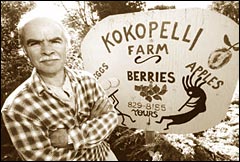Climate Food and Agriculture
All Stories
-
America’s national feast has seen better days, but remains well worth preserving
In every era the attempt must be made anew to wrest tradition away from a conformism that is about to overpower it. — Walter Benjamin, “Theses on the Philosophy of History” Eat, drink, and be mindful. Photo: iStockphoto Does Thanksgiving suck? There’s certainly a potent case to be made. In a land where communal eating […]
-
How to pick wines that don’t taste computer-programmed
How to choose wine for the Thanksgiving table?
There will either be pressure, financial and otherwise, to grab big bottles of cheap plonk off the supermarket shelf, or conversely, pressure to consult Wine Spectator or some other "expert" source and find bottles receiving high scores. Resist both impulses. Here's why -- and how.
-
Umbra on eating locally in winter
Dear Umbra, I live in New Hampshire, and I am getting ready for the long, cold winter. I try to eat locally, but with no year-round growing season here and such a dense population, most of the food comes from elsewhere. I was wondering what I could do to reduce my impact during the winter […]
-
No need to serve gussied-up Coors with so many real craft beers available
First bit of Thanksgiving advice: Prepare to be bombarded by bits of Thanksgiving advice.
Second bit: When you're choosing beer for the holiday table, don't get hoodwinked into buying tarted-up swill from a corporate brewer.
-
Two non-turkey recipes for the Thanksgiving feast

Thanksgiving is a funny holiday. It's a weird mix of frenzy and sloth, gratitude and greed. What should be a fun and peaceful time spent with relatives and friends is often preceded by the chaos of having too much to do and too little time in which to do it.
If you are the person responsible for cooking the Thanksgiving meal, you know that Extreme Grocery Shopping is the hallmark of the holiday. Simply getting your groceries home can be the stuff of nightmares if you live in a crowded city or suburb. Cooking the meal is a cakewalk by comparison.
Every year as I approach the local Whole Foods in the days running up to Thanksgiving, I see couples in the parking lot dividing their lists in two, synchronizing their watches, and saying things like, "Commencing operations at Oh Seven Hundred! We reconnoiter in Spices and Baking Needs! Go! Go! Go!"
-
Eric Schlosser on America’s food industry and his delicious new film
Eric Schlosser on the set of Fast Food Nation. Photo: Matt Lankes/ © Fox Searchlight Eric Schlosser sat unassumingly — and almost out of place — in a floral armchair in a spacious, elegantly decorated suite on the 10th floor of Seattle’s Fairmont Olympic Hotel. Behind him, a poster rested on an easel. It featured […]
-
A former McDonald’s cook explains his return to the family farm
Working at McDonald’s got me to college, for which I thank the world’s largest restaurant chain. I worked there for three years, beginning at about $1 an hour, during the middle of the 20th century. Back then, a buck bought something. I consumed tons of hamburgers and fries and gallons of milkshakes for free — […]
-
Donate wild salmon instead of tuna
It's hard to believe that the holiday season is already upon us. Despite the mall stampedes, fruitcake overload, never-ending traffic jams, and hideous reindeer sweaters, I'm looking forward to spending the holidays with my family. I can almost taste my mother's mince pie, and I am ready to play backyard soccer and touch football with my daughters and my nieces and nephews.
-
The film opens nationwide Friday
Find out what author Eric Schlosser has to say about the film.
I wasn't sure what to expect when I sat down in the mostly empty theater for the press screening of Fast Food Nation last month. The book is fascinating ... but fact-heavy and not character-driven. I knew this movie was a narrative, following the lives of fictional workers producing (and marketing and serving and eating) food at fictional fast-food chain "Mickey's." I had seen the trailer featuring Little Miss Sunshine cutie Paul Dano serving a "Big One" from off the prep-room floor and Greg Kinnear getting a whiff of "smoky meat" flavoring. I thought the movie might even be a comedy.
But I left the theater feeling like I had seen a horror film. During many of the meat-packing scenes, the gore-level was on par with something like Saw III. (Or I would assume, anyway -- my eyes were closed during the most gruesome scenes. And I've never seen Saw III ... but both involve large saws.) The scariest part about the film, though, is that -- to the best of Eric Schlosser's and Richard Linklater's screenwriting abilities -- it accurately portrays the fast-food industry.
-
The Case of the Mislabeled Case
Wal-Mart accused of incorrectly labeling organic products Ah, Wal-Mart — always reliable for some good old-fashioned eco-drama. This week, the Cornucopia Institute, an activist group representing small farmers, filed a complaint with the U.S. Department of Agriculture that accuses Wal-Mart of incorrectly labeling or otherwise misrepresenting various products as organic in some stores. Visiting a […]

